The mission of the nonprofit Coolidge Corner Theatre is to entertain, inform, and engage — building a vital community through film culture.
History
The Coolidge Corner Theatre is New England's most successful independent, nonprofit cinema. Built as a church in 1906, it was redesigned as an Art Deco movie palace in 1933 and has never closed its doors to the public since then. Located in the heart of Brookline, Massachusetts, it was the community's first movie theater and now, a non-profit foundation since 1989, it celebrates the experience of cinema by presenting the finest international, documentary, animated, and independent film selections and series.
From the sponsoring of china giveaways during the Depression to the prestigious Coolidge Award events inaugurated in 2004 honoring groundbreaking international artists from the world of film, the Coolidge Corner Theatre has played a unique and indelible role in the development and social history of the town of Brookline.
The many changes at the Coolidge in recent years have greatly altered the perception of the Theatre in the eyes of the public. The Coolidge has, in fact, experienced nothing short of a renaissance, transforming itself from a down-at-heel but beloved experimental arts venue to a stable, prosperous, and highly valued institution in the community.
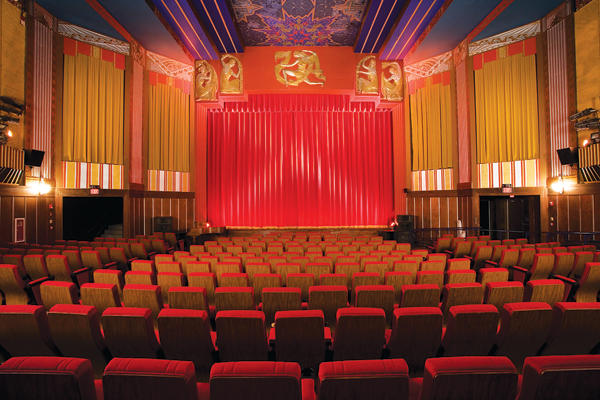
A History of the Coolidge Corner Theatre: 1933 – present
Below, trace the journey of the Coolidge, from its Depression-era beginnings to its present-day status as an Art Deco community treasure. The source material is derived from Susan Quinn’s invaluable book, Only at the Coolidge: The Story of a Remarkable Movie Theater.

From ‘Celluloid Menace’ to Art Deco Treasure
It took the citizens of Brookline 17 years to say ‘yes’ to building a moving picture theater in their town. Many feared that movies would corrupt the youth, but in the wake of the Great Depression, the town relented, granting the Harvard Amusement Company the right to build a 1500-seat theater over the Beacon Universalist Church on Harvard Street. The Coolidge Corner Theatre opened its doors in December 1933.

Abandon All Care
On its third anniversary, in 1936, the Coolidge ran an ad in the Brookline Chronicle celebrating the theater as a "meeting place for the community, bringing culture and relief from care within the reach of all." That summed it up nicely.
Pictured: Harvard Street in 1936.
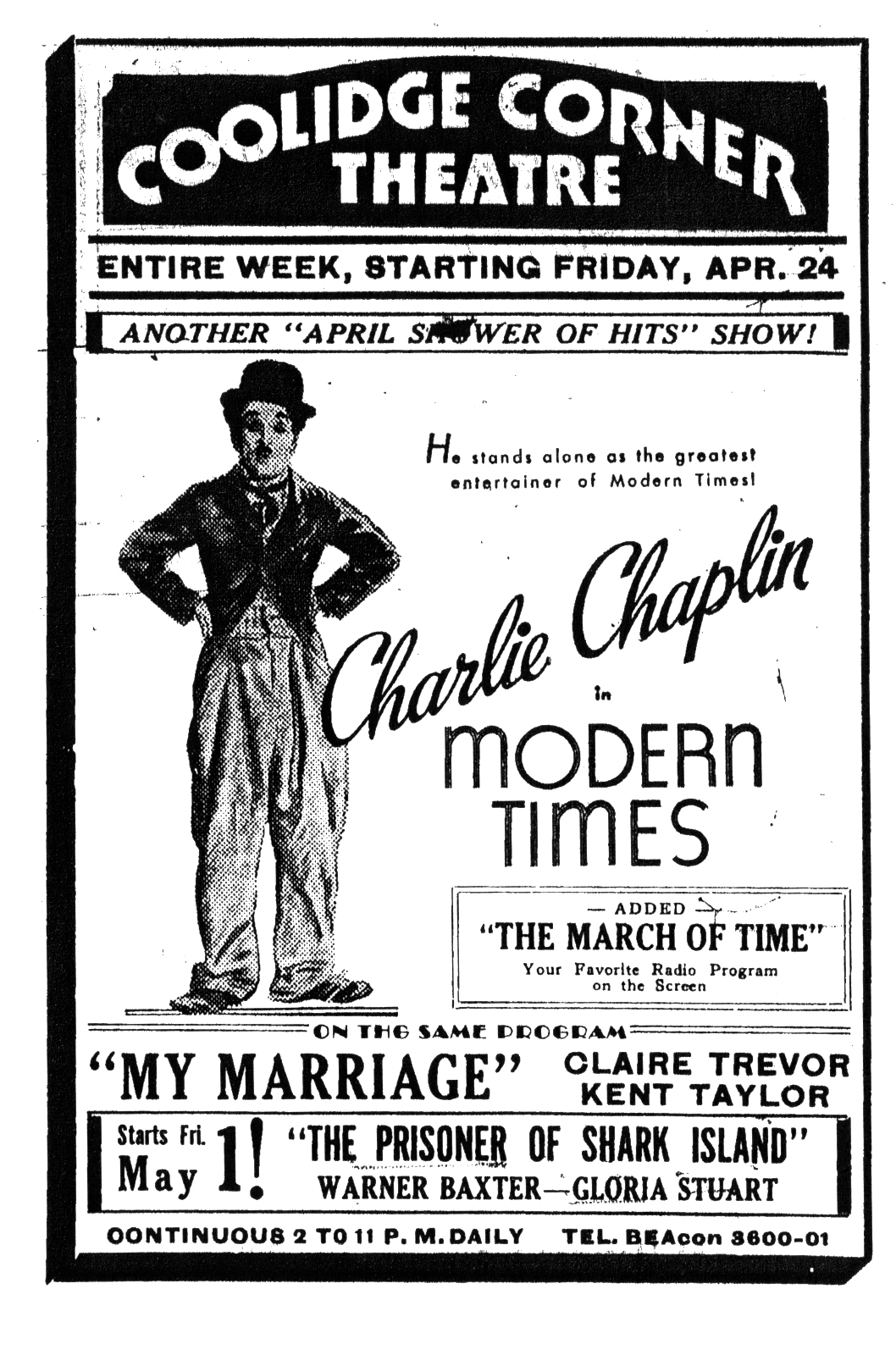
Bringing the Best of Cinema to Brookline
All the movie greats of Hollywood’s Golden Age made appearances on the big screen at the Coolidge: Charlie Chaplin, Shirley Temple, Cary Grant, Katharine Hepburn, Ingrid Bergman, Errol Flynn, Humphrey Bogart, Marilyn Monroe, Marlon Brando and James Dean, among many others.
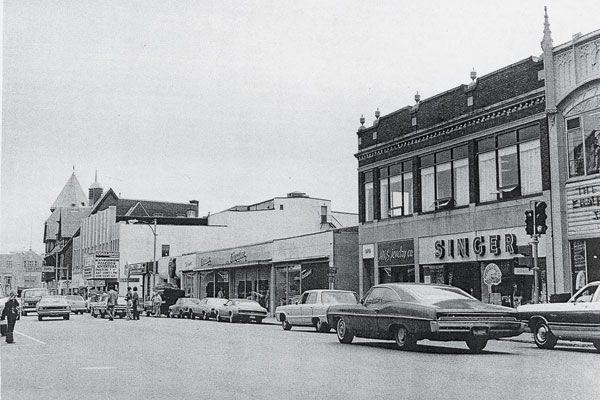
A Change in the Air
The Coolidge began to struggle economically during the 1970s, relegated to second runs of films as multiplexes in malls proliferated. In order to survive, a change was necessary: in 1977, Justin Freed took over the theater, using his own movie-savvy to transform the Coolidge into an arthouse theater.

The Freed Years
Fueled by a personal passion for cinema, Justin Freed was able to redefine the Coolidge as a venue for the unexpected: classic revivals, foreign movies new and old, and independent films – programming that greater Boston movie lovers could see nowhere else. He also oversaw the twinning of the Coolidge in 1979, a move that closed off the balcony and created a second screen, which thereby enabled him to program repertory films.
Pictured: Cary Grant & Katharine Hepburn, as rendered by Bill Commerford, who designed all Coolidge literature during the Freed Years.
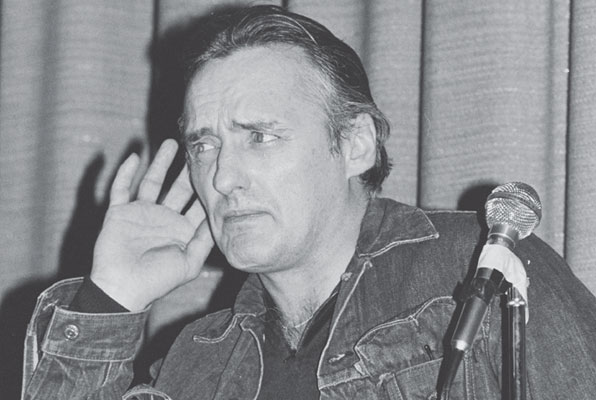
Top-notch Revivals and Special Events
Justin Freed played in a key role in (re)introducing audiences to the genius of Preston Sturges, Fred Astaire, and Buster Keaton, among many others. He also made the Coolidge a go-to destination for special events, which included appearances by Norman Mailer, Frederick Wiseman, Al Green and Dennis Hopper (pictured here at the national premiere of Out of the Blue).
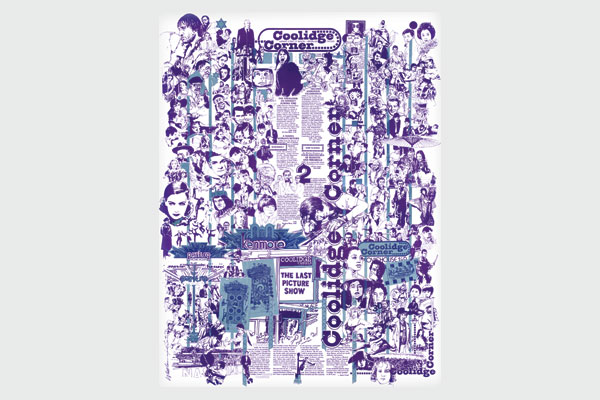
The Brink of Closure
Unfortunately, Justin Freed’s innovative programming was not enough to sustain the Coolidge financially as competition for art films grew and pay-TV and VCRs began cutting into the movie theater business. In the spring of 1988, after exhaustively exploring many options to preserve the theater, Freed reached a purchase-and-sale agreement with a developer, who planned either to demolish the building or to convert it into retail and office space.
Pictured: The last calendar of Commerford and Freed, listing and illustrating over 240 films from their reign.
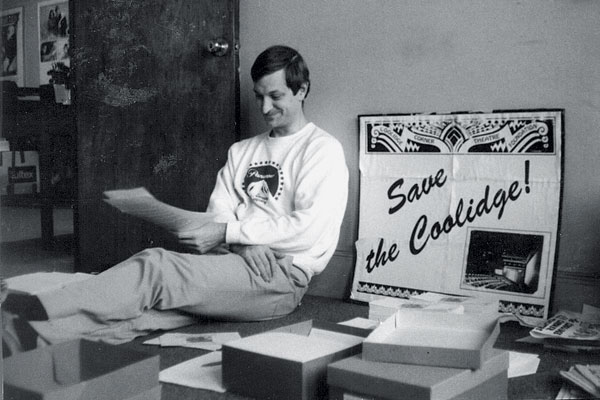
The Community Rallies
In the fall of 1988, local film teacher David Kleiler spearheaded a grassroots movement to save the Coolidge. His group, dubbed the “Friends of the Coolidge,” scored a major victory that year when they convinced the Brookline Historical Commission to agree that the theater was of historic significance to the town of the Brookline, a move that halted action by the developer for a full year. Shortly thereafter, the Friends of the Coolidge transformed into a non-profit entity, The Coolidge Corner Theatre Foundation.
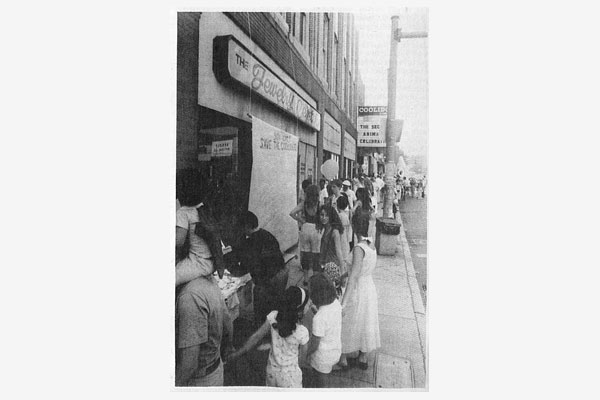
The Race to Save the Coolidge
In January 1989, The Coolidge Corner Theatre Foundation launched a capital campaign to raise the $2.6 million needed to purchase the building from the developer. As the September deadline loomed, public support grew. As the clock ticked, four hundred local residents turned out to form a huge circle and “hug” the building.

The Rescue
Despite the outpouring of public support, the Foundation was unable to raise sufficient funds to save the Coolidge. All appeared lost – and then, just like in the movies, a surprise hero came to the rescue. Harold Brown, a realtor and Brookline resident who had loved the Coolidge in his youth, made a proposition: his Hamilton Charitable Foundation would purchase the theater and lease it to the Coolidge Foundation for 99 years. On November 8, 1989, David Kleiler cut a celluloid ribbon to mark the reopening of the Coolidge Corner Theatre (pictured here). As the marquee triumphantly announced: WE DID IT – ON WITH THE SHOW.
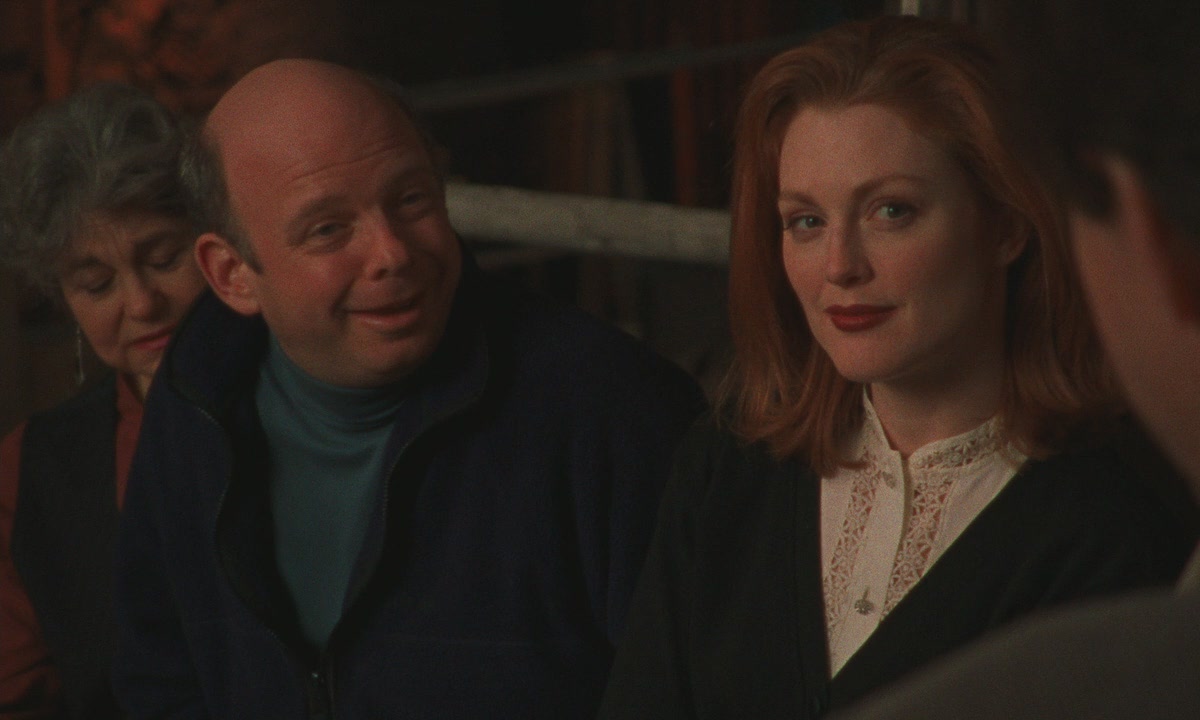
Transitions
David Kleiler took the reins at the newly-restored Coolidge in 1989, programming arthouse hits such as Vanya on 42nd Street (pictured here) and Camille Claudel. Day-to-day operations remained difficult, however, and in 1993 he left the theater, which faced an uphill struggle financially. In what proved to be a vital move, then-board chair Chobee Hoy brought in Sasha Berman and former Brattle co-owners Marianne Lampke and Connie White to stabilize finances and reestablish relationships with distributors. As Hoy later remarked, “David saved the Coolidge the first time. Connie, Marianne and Sasha saved it a second time.”
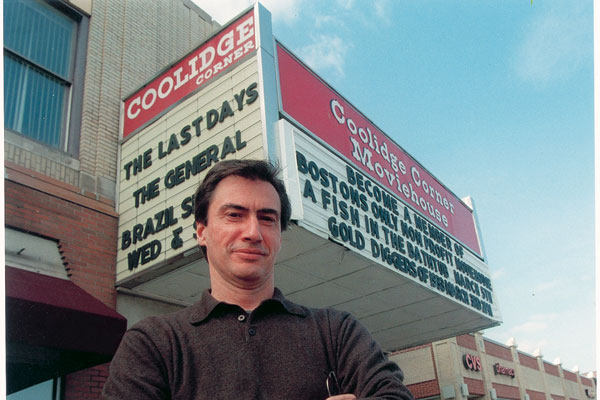
A New Beginning
As the theater found itself in an increasingly stable position, a dynamic artist named Joe Zina (pictured here in front of the old marquee) joined the board. In 1999, Zina decided to embrace a new personal challenge, and accepted the position of Executive Director. As he took over, Zina faced the immediate challenge of the Coolidge being $350,000 in debt, most of it in back rent owed to landlord Harold Brown. One of Zina’s first moves was to meet with Brown, who graciously agreed to forgive the debt, thereby allowing the Coolidge to keep its doors open.

The Restoration
With the debt out of the way, Zina and new board chair Mike Mayo were able to embark on a much-needed capital campaign to raise funds for a new roof, new flooring, new seats, a reconfigured foyer and concession stand, a retractable stage, and new lighting. Old art deco details were brought back to life, and a brand-new marquee (pictured here; designed by Mark Favermann) heralded a new era for the theater. In addition, two smaller digital screening rooms were added to host premiere screenings of smaller independent films and hold-overs from the big houses.
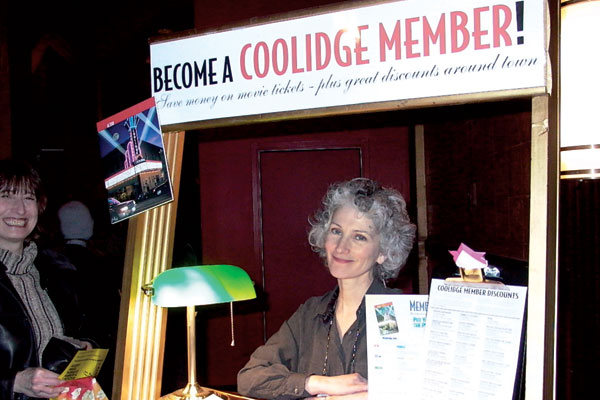
An Anchor of the Community
Renovations underway, Zina turned his focus to the day-to-day operations of the theater, assembling a talented staff, many of which still work there today, including Connie White as programmer, Marianne Lampke as publicist, and Andrew Thompson as Theater Operations director. Coolidge programming expanded to include Kids Variety Shows, films for the Deaf and Hard-of-Hearing, Midnite Movies, an Opera Series, Science on Screen, and Senior Matinees.

The Coolidge Award
Another signature program that has emerged over the past decade is the annual Coolidge Award. Established in 2004 from a generous grant from board member Rikk Larsen’s family foundation, the Award celebrates a film artist whose work is consistently original and challenging. Past honorees have included Zhang Yimou, Meryl Streep, Thelma Schoonmaker, Jonathan Demme, Werner Herzog, and more.
Pictured here: Robert Altman with Meryl Streep in 2006 (photo by David Fox).
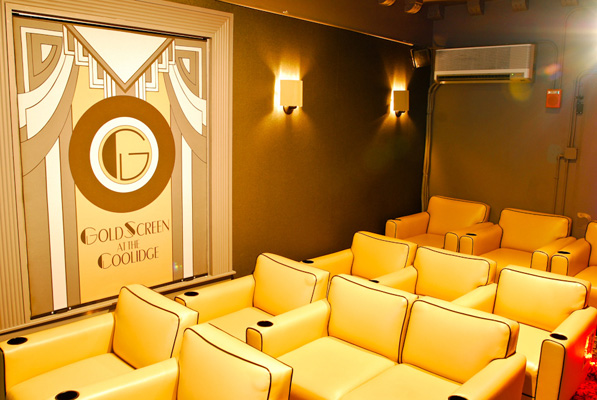
Moving Forward
After a decade at the Coolidge, Joe Zina decided to move on, leaving the theater in infinitely better shape than it was when he took over in 1999. Denise Kasell, a veteran of the film and entertainment industry, took over as Executive Director from Zina in January 2009. Following Kasell in 2013, after a national search, longtime board member Katherine Tallman was named Executive Director. More new programs have been introduced, including Cinema Jukebox and Rewind!, and the Coolidge continues to thrive over 85 years later.

About The Author
Susan Quinn is the award-winning author of 'A Mind of Her Own: The Life of Karen Horney' and 'Marie Curie: A Life.' Her most recent book 'Furious Improvisation: How the WPA and a Cast of Thousands Made High Art out of Desperate Times,' was described by NPR as "fascinating." Quinn lives in Brookline with her husband, Dan Jacobs, a psychoanalyst who participates in the Coolidge's Off the Couch series. The Coolidge is grateful for the time and dedication she put into researching our history.
